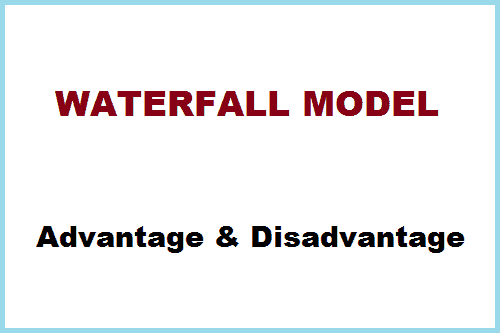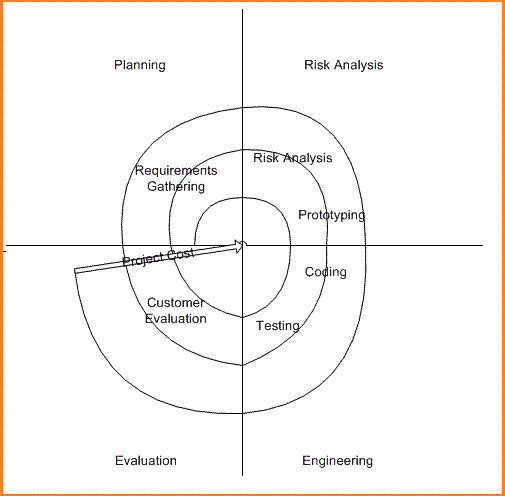The spiral model is a Meta model used for SDLC in Software testing. It is the combination of a waterfall model and iterative model. The diagrammatic representation seems like a spiral form with many loops hence it is called a spiral model.
The spiral model represents the phase of the software development process to carry the same activities over several numbers of cycles to elucidate system application, its requirement, and its solutions.
Why Spiral Model is called Meta Model?
The spiral model is also known as the Meta model since it encompasses the complete life cycle models of the software. This model inherently builds the risk handling process. This model is best suitable for challenging software products. The process of iteration in spiral continues throughout the life of the software.
When to use Spiral Methodology in SDLC?
Each phase in the spiral model starts at a goal and ends with the client reviewing the process. The development team starts with a set of requirements and moves through each development phase. This model in SDLC can handle risks.
The project development team in SDLC adds a functionality module to the ever-increasing spiral to make the application ready for the production phase.
The spiral model is recommended for a large project. It is also used for the creation of a prototype with medium-high risk projects.
The spiral methodology is used in SDLC for high-risk projects as the risk handling in the spiral model is easy and comfortable to use. At the same time, it is not recommended for small projects.
Spiral Model Phases:
The spiral model is used in the software industry with the maturity that involves minimum low risk for the customers. The spiral model includes the four phases of the software development process and the following activities are performed during the execution:
Planning: The phase starts with the planning of the business requirements. It includes project cost, schedule, resource and iteration. It also includes the best communication between the project analyst and the customer.
Risk Analysis: The identification of potential risk is done in risk analysis. The risk analysis includes testing, coding, deploying software and risk mitigation strategy planning.
Engineering: It includes designing, coding, testing, and deploying the software at the customer point.
Evaluation: Once the testing and monitoring works are done, the phase is sent for evaluation. At the end of the iteration, the customer evaluates the software and gives feedback. The evaluation also includes cost overrun and slippage.
The software development process is passed repeatedly through these phases in iterations for the desired customer output. This repeated process model is called the spiral model.

Advantages of Spiral Model:
The spiral model is performed with the idea of the iterative process with systematic control to perform various phases in the software development process. Below are the listed advantage of spiral models over long term projects:
- The main advantage of the spiral model is, it’s good for large and complex projects. The software is produced in the SDLC and it is flexible to use.
- This model is best suitable for high-risk projects. Especially for the business which needs customized app development.
- The spiral model helps to change the requirements at each phase and it can be incorporated without any risk and error.
- The addition of new functionality can be added at any subsequent models without any risk.
- The main advantage is it is flexible for risk handling in spiral model at every phase. It is the best development model for risk analysis. The software is being produced in the software life cycle.
- It provides the best customer rating. It is easy to involve customers in the early phase of development. It helps for better documentation control and repeated development in risk management.
- The prototype is built in small fragments in an easy way that reduces the project cost. Continuous development helps in risk management.
- The model provides strong approval of the project and the best documentation control. The development is fast and furious.
The Spiral Model in SDLC is best suitable for the customer based software applications. It naturally synchronizes with any software product that involves risk handling in spiral model. The desired output provides minimal risk to the customer and the development firms.
The Disadvantage of the Spiral Model:
There are few disadvantages occur in the spiral model that includes:
- The spiral model is best suitable for small fragments but not suitable for small projects. The cost of the spiral model is quite expensive for small projects.
- When compared to other SDLC models, the spiral model and its process are more complex to use. The experienced person who has sufficient knowledge in spiral can handle the models in a better way. But the company has to pay a huge amount for hiring the right candidate.
- The phases of the software development process cannot be finalized at the initial stage. So the estimation and time will not be determined.
- Spiral may go indefinite. The developer faces difficulty in time management as the number of phases used is unknown.
- The entire project is depending on risk analysis and it requires expert professionals to handle the entire project.
- As the spiral phase is not declared, there may be large numbers of middle stages required to complete the documentation.
- It is hard to define the objective, number of phases, verifiable milestones, exact documentation, and time estimation of the project.
- The end of the project, time, and cost is not predictable in this model. It is much dependable on Risk Analysis and requires highly specific expertise.
The spiral model is consistent with the approach of multiple software builds and follows the strict management rules to complete the process. There is a risk of running the spiral model in an indefinite loop.Hence, it is highly recommended using the spiral model over the long term project. To make the project successful, it is important to run the phases of the software development process with the discipline of change with proper development and deployment of the product.



